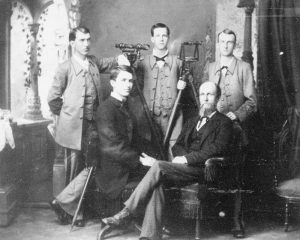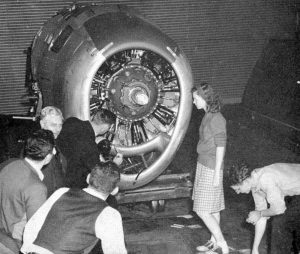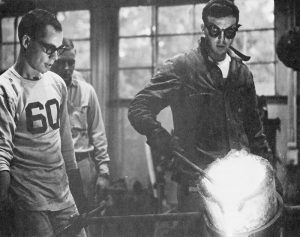History of the College

William Vaughn and engineering students about 1881.
Engineering education was instituted at The University of Alabama in 1837 with the offering of a formal, two-year course of study in civil engineering (under the aegis of applied mathematics). Frederick Augustus Porter Barnard was the first professor of engineering.
From 1860-1900, The University of Alabama became a military institution, and military engineering became an offered class.
The College of Engineering was organized as a separate division of the University in 1909 with the opening of B.B. Comer Hall. At the time, Comer Hall was called one of the largest and best equipped engineering buildings in the United States. Civil and mining engineering were the two existing programs, and the first classes of electrical, mechanical and metallurgical engineering were taught. Chemical engineering classes followed in 1912.
The College of Engineering began to experience an upturn in enrollment in 1919 when students numbered more than 200 for the first time. The number of freshman engineering students would continue to rise through the 1920s, and the yield of engineering graduates followed upward. Enrollment topped 300 in 1928 and 43 engineering degrees were awarded that year.
The 1930s continued as a decade of prosperity for the College. Fed by an influx of northern students, enrollment grew rapidly up to 469 in 1930 and 726 in 1932. The College gained much new teaching and laboratory space in 1936 with the completion of a new engineering building, later to be called Hardaway Hall. Hardaway Hall provided spacious and modern accommodations for mechanical and civil engineering. There were 26 teachers on staff by 1936.
The aeronautical, industrial and metallurgical curriculums also were developed during the 1930s. The aeronautical program was described as the twentieth century’s ultimate symbol of modernism because of the airplane. The industrial engineering program attracted an increasing number of students interested in managing industrial production. The metallurgical program was developing from the chemical engineering area because chemical was reducing its commitment to metals.
The College of Engineering received a strong endorsement in 1937 when the Engineers’ Council for Professional Development accredited six of its eight programs. The council had been formed in 1932 to ensure that engineering education in the United States achieved both technological sophistication and breadth of learning. This was the first nationwide accreditation of engineering education. Alabama ranked in the top 12 percent of engineering schools in the country.

Aerospace engineering students gathered around a propeller in 1946.
During the 1940s, the country and the University were greatly affected by World War II. The College of Engineering’s greatest contribution came not in technological research but in technical training of military personnel. Its first effort was the flight instruction program run by the aeronautical engineering department. The aeronautical professors trained thousands of pilots and gave instruction to ground crews.
Enrollment in engineering also increased during the war period, from an average of 700 students a year to more than a 1,000 in 1943. After the war, enrollment swelled to more than 2,300 students, thanks in part to the GI Bill of Rights.
The 1950s were considered a demoralized time for engineering. The enrollment in the College fell to about 600 in 1952. The decrease in enrollment primarily reflected the educational maturation of the GI generation and the job market was engulfed with engineers.
Increases in budget helped considerably in the early 1960s. The College’s budget increased 170 percent; there were 96 professors on staff in 1964; and the average salaries of full professors grew from $5,000 in 1953 to $10,200 in 1963. In addition, the Mineral Industries Building (now H.M. Comer Hall) opened in 1962.

Engineering students in the foundry in 1968.
Racial segregation, one of the main social issues of the 1960s, greatly affected the College of Engineering in not only attracting students, but it became increasingly difficult to attract top-notch faculty. Gov. George Wallace’s “stand at the schoolhouse door” only exacerbated the tensions at the University and in the state.
The 1960s also became a growth period in graduate education in the College. By 1962, the College offered the Ph.D. in four areas (chemical, electrical and mechanical engineering, and mechanics). The number of graduate students rose sharply in the 1960s. The first Ph.D. was awarded in 1964 in chemical engineering.
Rapid changes in engineering were brought on by computers in the late 1960s and early 1970s. In 1971, the College of Engineering created a department of computer science and operations research. At the time, the college’s equipment included an IBM, a UNIVAC, and an RCA 110-A. The computer science curriculum would enjoy great popularity among the students as the impact of the information revolution grew.

Engineering students in the lab in 1977.
The demographics of the College started shifting in the late 1970s and early 1980s with an increase in the number women, minorities and international students attending classes. Women had enrolled at the College of Engineering since the 1920s, but until the 1970s their presence was seen as a novelty.
The 1980s saw a resurgence in sponsored research under Dean Robert Barfield as changes by then-President Joab Thomas let engineering keep more of research grants for lab upgrades, facility improvements and graduate assistants. When the College celebrated 150 years in 1987, there was an increase in pride among faculty, students and alumni, and three years later he oversaw the dedication of two buildings that, while not wholly belonging to engineering, were the first new facilities in more than 30 years for the College. The Rodgers Science Library took the engineering and science collection from a cramped space in Gorgas Library to its own building, and the Tom Bevill Energy, Mineral and Material Science Research Building was the first UA facility dedicated solely to research.
President Roger E. Sayers, who succeeded Thomas, continued an emphasis on research, as did Barfield’s successors, Raymond W. Flummerfelt and Timothy Greene. Through it all, though, was a focus on undergraduate education, the lynchpin of goals laid out later by former President Robert E. Witt, who pushed enrollment expansion along with more quality research.

Dr. Ajay Agrawal discusses quiet-combustion technology with students in 2012.
Balanced with research, it the College’s public mission of preparing students not just to compete for jobs in the region but also globally. Part of that preparation is improved facilities, and in 2013 the College opens its second building in two years after the South Engineering Research Center, or SERC, opened earlier this year. The building will be the fourth in a quad of science and engineering buildings that began in 2004 with the opening of Shelby Hall. Although SERC and the fourth phase are solely for engineering, Shelby Hall and the Science and Engineering Complex, opened in 2009, house portions of the College.
The new buildings help attract professors and their research, building on momentum already established. This century, research expenditures in the College increased by 50 percent to more than $22 million by spring 2011, and new research awards to faculty increased more than 40 percent to more than $17.5 million.
New facilities are designed to blur the line between research and education as undergraduates often work alongside their graduate counterparts in the lab. They also encourage collaboration with the sciences, such as chemistry, biology, physics, math and geology, that share the same buildings with engineering faculty.
In 2005, the then dean, Dr. Charles L. Karr pushed the College to take advantage of being part of a diverse university with a strong liberal arts and business programs that helped instill a spirit of innovation and creativity in UA engineering graduates.
Now with the hiring of Dr. Clifford L. Henderson as dean, engineering and computer science enrollment continues to surge at The University of Alabama.
Based on documentation from A Promising Field: Engineering at Alabama, 1837-1987 by Robert J. Norrell, The University of Alabama Press, 1990.
Photos courtesy of W.S. Hoole Special Collections Library.